Formula One: 1987 Belgian GP
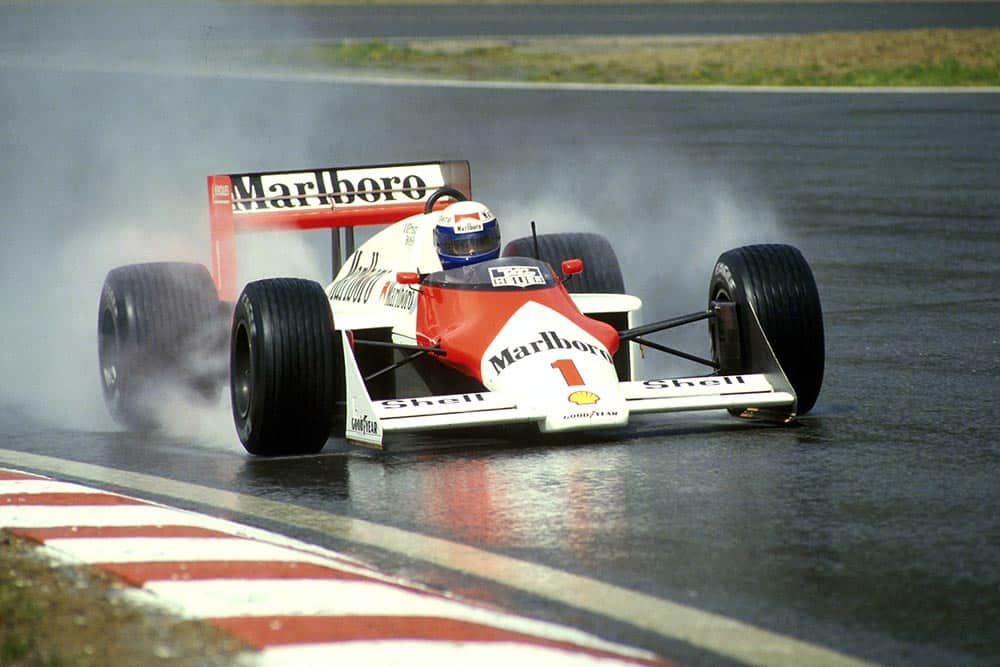
Winner Alain Prost charges through the rain in his Mclaren MP4-3.
© Motorsport Images
Near disaster
After the race at Imola, in Italy, the “circus” moved north to Belgium for the next round in the Formula One Championship series. Unlike a true travelling circus the teams did not move en bloc, but all sped back to their homes in Italy, Germany. France and England where rebuilding, development, testing, and experiment continued, together with analysis and reckoning on the results of the Imola race. Some teams even found time to send their “test team” with a development car to a circuit for some practical test work. In Formula One you cannot stand still and rest on your laurels; the pace at the head of the field is very high and competitive. Even at the back of the field you have to keep at it, or you will get left behind and eventually get left out altogether.

Nelson Piquet in his Williams FW11B.
© Motorsport Images
By Thursday May 14th the teams were all re-assembled, this time in the paddock on the circuit of Spa-Francorchamps in the southeast corner of Belgium, not far from the frontiers with Germany and Luxemburg, and the spectacular countryside on the edge of the Ardennes forests in the Haute-Fagnes. The National Circuit of Spa-Francorchamps is either good or bad, there is very little in the way of compromise. When the sun shines it is glorious, when it rains it is foreboding and gloomy,but either way it is the best circuit on the International Calendar; some would say it is the best circuit in the world. Certainly, anyone who calls himself a professional Grand Prix driver loves it; they also hate it at times, but just suggest that somebody else could take their place for this one race, and see what the reaction would be.
For the two days of practice and qualifying it rained; not continuously, but heavily and at intervals between bouts of sunshine, and on Saturday afternoon it was so cold that rain turned to hailstones and there was snow on the distant hills. Friday qualifying was a complete lottery and the times were fairly meaningless, though the wet conditions did allow drivers to demonstrate their skill and delicate touch, and some stood out from the general pack. It was not only the stars who shone through the murk, the likes of Senna, Prost, Piquet and Alboreto were expected, but Alessandro Nannini in a Minardi, and Ivan Capelli in the 31/2-litre Cosworth-powered March, were shining with similar brightness.
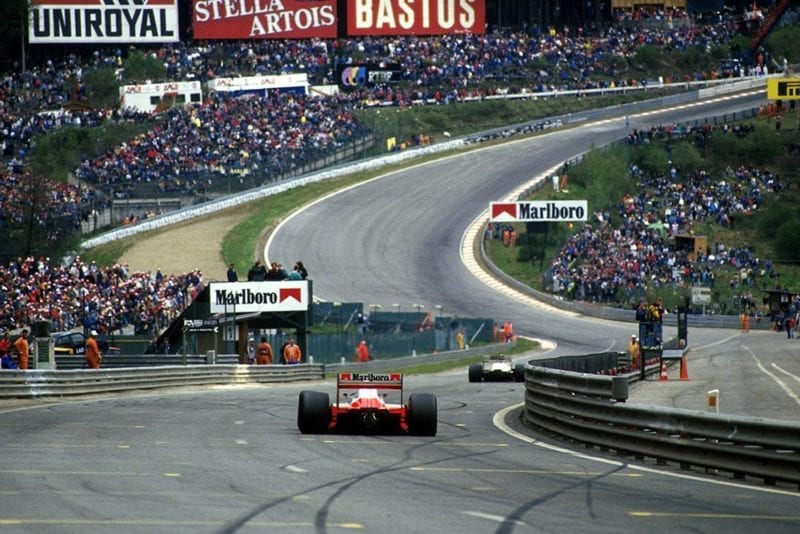
Alain Prost approaches Eau Rouge.
© Motorsport Images
On Saturday the bouts of sunshine became more prolonged and the first three-quarters of the qualifying hour were near-perfect so that the results were more realistic; it was significant that Honda-powered cars took the first three places on the grid followed by the two Ferraris with their new 90-degree engines, then the reigning World Champion with his Porsche-powered McLaren and the two Ford-powered Benettons sandwiching a lone Brabham with “laid down” BMW power. The front part of the grid still looks very healthy, even if the “little yellow men” are dominant. During the qualifying hour the speeds recorded at the timing line and just before the braking point at the end of the long straight running uphill to the summit at Burnenville made interesting reading.
The timing line is at the beginning of the short straight to the hairpin at La Source, and it is approached from the “bus stop lay-by” chicane round a flat out left-hand curve on full acceleration. Mansell broke the beam at 169 mph, Piquet at 167 mph and Senna at 166 mph, which caused the Honda opposifion to suggest that the Japanese had discovered a way of circumventing the 4-bar turbo pressure limit controlled by the FIA pressure valves issued to the teams prior to the meeting. What is amusing is that those “technical wallahs” who claim to know how it is done are connected with various teams and you wonder why they are not doing it, if it is so easy! Some people go out of their way to present a “whiter than white” character; or do I mean caricature? No-one seems prepared to admit that the Honda is the best engine.
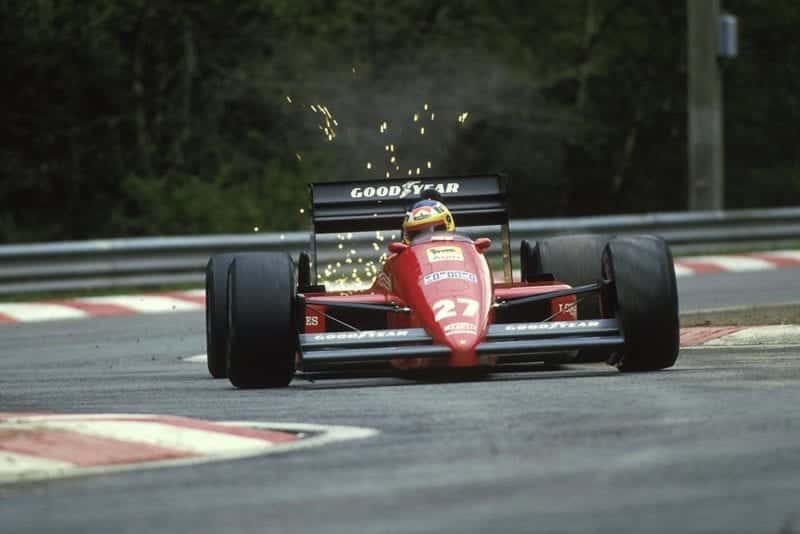
Michele Alboreto in his Ferrari F1-87.
© Motorsport Images
At the timing line, other speeds were Prost 165 mph, Cheever 163 mph, Johansson 163 mph while others were some 10 mph slower than Mansell. The Tyrrells, with their “vintage” or “historic” 31/2-fitre Cosworth engines could only manage 144 mph. It is worth bearing in mind that at 165 mph a turbocharged car is coming nicely on song, so the good ones were going into the braking area for the bottom-gear hairpin at somewhere around 180 mph. Up the long hill after the abrupt “Raidillon” following the Eau Rouge bridge the turbo cars really got into their stride and grunt was the all important requirement. This time it was Piquet at the top of the list, his Williams-Honda going through the speed trap at 203 mph, while Mansell was at a mere 200.9 mph!
Suprisingly the Arrows of Cheever and Warwick were next with 199 mph and 198 mph respectively, the Heini Mader-built “upright” four-cylinder turbocharged BMW engines, financed by Megatron, obviously pushing out a lot of power without going over the 4-bar limit of boost pressure. The Porsche-engined McLarens were doing 197 mph and then the speeds dropped dramatically down to the 190 mph of Boutsen’s Ford-powered Benetton. The poor old “historic” Tyrrells could only pull just over 170 mph. From these speeds the brakes had to anchor everything up for the third gear ess-bend leading onto the new part of the shortened Francorchamps circuit, before the glorious plunge down into the valley and through the twists and turns down to the lower road to rejoin the original track from Stavelot to La Source. The circuit may be only half the length that it was in “the good old days”, but it is still breathtaking driving round in a normal saloon car. It must be sheer heaven for a real Grand Prix driver in a 900bhp Grand Prix car.
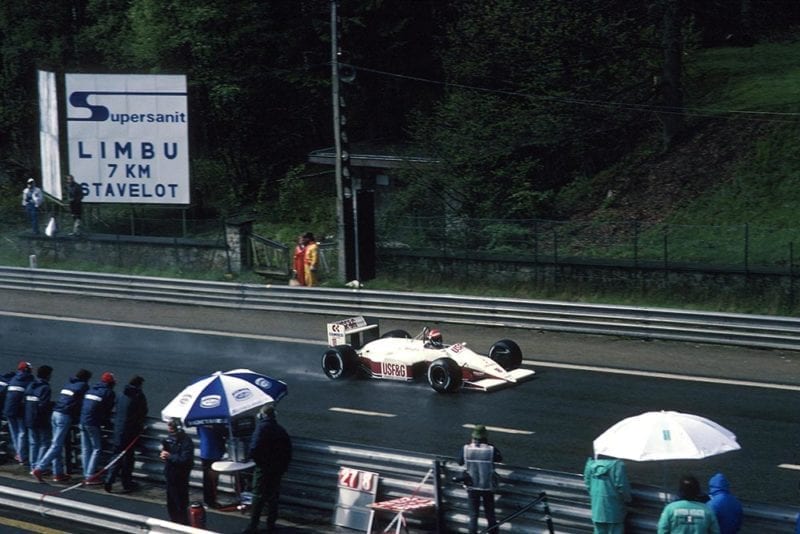
Eddie Cheever in his Arrows A10 passes the pits.
© Motorsport Images
Mansell’s fastest lap in qualifying, which gave him pole position, was 1 min 52.026 secs, an average speed of 138.578 mph, and that includes a first-gear hairpin bend! This was well over two seconds quicker than Piquet’s pole-position time of last year, and the cars are supposed to be slower, with limited boost and no super-sticky tyres. It makes one wonder whether Q-tyres and Q-engines last year were real or imaginary. Admittedly the 1987 weather was almost ice-cold, so engines were really having a good time and were breathing well, but even so two seconds on an unchanged circuit makes You think.
Everyone had their fingers crossed for Sunday and though the day was dull and overcast the rain kept off, conditions were dry and considering the poor practice days a pretty good crowd assembled on the hillsides, not too many indulging in the luxury of a very expensive grandstand seat. After the regulation 30 minute warm-up session, during which fuel consumption and tyre wear were guessed at by most teams, due to practice days not allowing much in the way of serious measurement, there was an unruly one-make race for Alpine-Renault GT cars. Then Daimler Benz AG put on a “demonstration” by two Golden Oldies, their 1937 Mercedes-Benz W125 straight-eight 5.6-litre supercharged GP car, driven by John Surtees, and a 1955 Mercedes-Benz W196 straight-eight 21/2-litre GP car driven by Stirling Moss, both cars looking splendidly prepared by the “Daimler-Benz Oldtimer Service”, it said on the overalls of the works mechanics. To complete the lunch hour the Lada Stunt Team put on a display of gymkhana acrobatics with normal looking Lada saloons that was incredible and worth missing lunch to watch.

Andrea de Cesaris in his Brabham BT56, finished 3rd.
© Motorsport Images
The Grand Prix de Belgique over 43 laps of the circuit was due at 2.30pm, and all seemed well as the 26 cars lined up on the grid with the two Williams cars on the front row. Everyone got round the hairpin and Mansell led them down over the Eau Rouge bridge and up the spectacular Radiillon. At the end of the opening lap the cars came out of the chicane and into the final left hand bend like bullets. Mansell (Williams), Senna (Lotus), Piquet (Williams), Berger (Ferrari), except that the red car had got away from the young Austrian. Rear wheel adhesion was lost as he booted it too hard, the tail came out and the Ferrari turned through 180-degrees as it went across the road in front of those following, sliding off on the left side of the road as the others passed by. It hit the guard rail going backwards and bounced back into the road just as Boutsen passed and the Benetton’s left rear wheel hit the left rear wheel of the backward-facing Ferrari.
With deranged suspension the Benetton skittered down the road, scrabbled round the hairpin and came to rest down the hill. Meanwhile the blow had pushed the Ferrari back on to the grass verge, so that no-one else struck it. After everyone had gone by Berger ran across to the pits, completely unhurt, and then the starter showed a red flag at the timing line, indicating that the race had been stopped as the field were away on lap two.
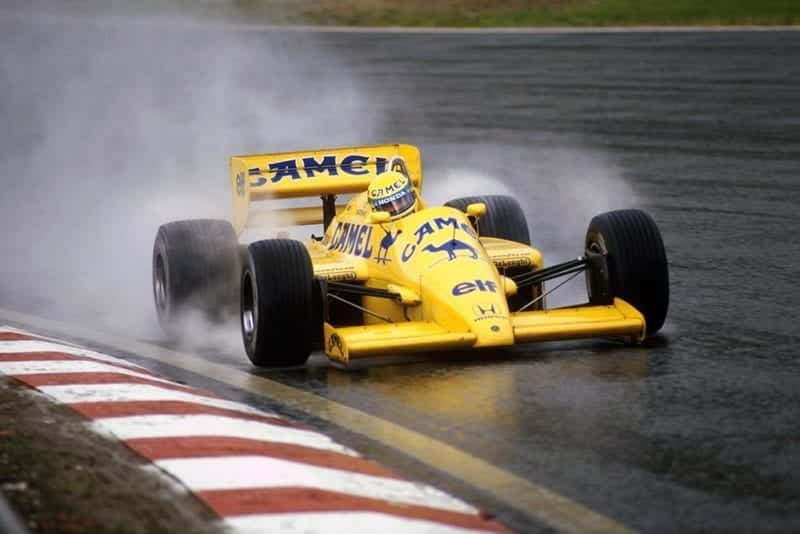
Ayrton Senna driving his Lotus 99T.
As the dust was settling after Berger’s spin there had been another accident. As Philippe Streiff crested the brow at the top of the Raidillon he lost control of his Tyrrell-Cosworth V8 and hit the barriers hard enough to break the Tyrrell in two, leaving bits spread aross the road. Jonathan Palmer was following in the second Tyrrell and smashed into the debris and within seconds the Tyrrell Team as a write-off, luckily with no personal injury. The Steward’s decision was that the race would be re-started, fuel tanks being allowed to be topped up, tyres changed if necessary, T-cars to be used and repairs to be made.
As the cars finished the second lap of the first race they stopped and reformed on the grid, Berger joining in with the spare Ferrari and Boutsen with the spare Benetton. There was only one spare Tyrrell so this was given to the rather ashen-faced Streiff. There was another parade lap, by 24 cars this time, as Campos joined Palmer as a non-starter, his Minardi having gone wrong, and then there was another good start, this time Senna making a real “Villeneuve start” and diving between the two Williams cars to lead into the hairpin and away down the hill.
By the end of the long climb to Les Combes Mansell had regained a lot of ground and closed on the yellow Lotus down into the valley. Going into the first of the fast ess-hoods in the valley, he got alongside the Lotus, but on the outside line. Foolishly, he tried to go round the outside of the Lotus on the tight right-hand bend, and next moment both cars were spinning to the outside of the track. The Lotus ended up stuck in the run-off bed of gravel, while the Williams was able to get back on the track after everyone had gone by. A grinning Nelson Piquet was now leading, followed by Alboreto and Prost, then Boutsen, Berger, Fabi, Patrese and Johansson. After Streiff had gone by, carrying the red light of the procession, a furious Mansell stormed by. Senna had to walk back.
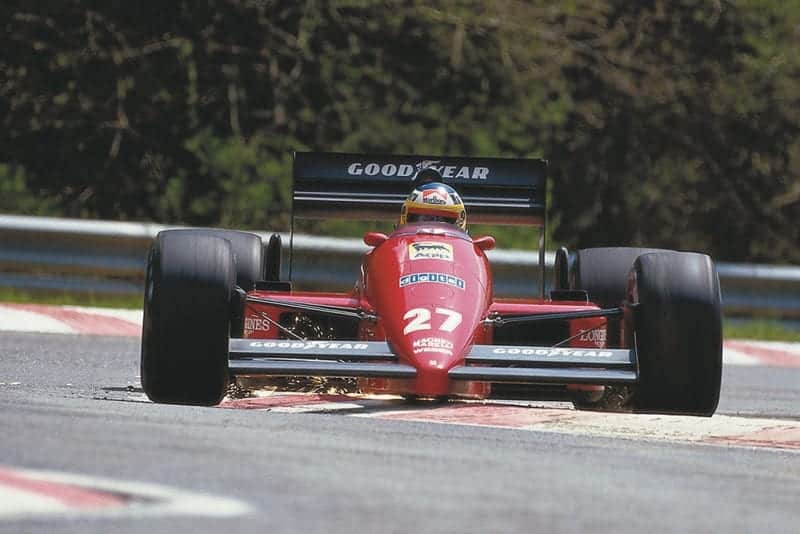
Michele Alboreto at the wheel of his Ferrari F187.
© Motorsport Images
Piquet looked secure in the lead, while Alboreto looked smooth and comfortable in second place and Prost in third place looked as always — calculating. This situation lasted until lap 10 when Piquet’s Honda engine spluttered and misfired, and Alboreto’s Ferrari coasted to a stop with broken transmission, leaving Prost comfortably in the lead without having to do any calculations. The spare Ferrari had lasted only a lap and before clouds of white smoke, suggesting melted pistons, poured out of the back and Berger trickled in to the pits to retire.
What had looked to be a good dice turned into a rather boring demonstration of the Prost smooth, unruffled driving technique, leading the race from lap 10 to the end, including a stop for new tyres. He didn’t exactly, have to battle for this victory, bringing his total to 27, equal with the total set up by Jackie Stewart. Any opposition there might have been fell by the wayside, Boutsen’s spare Benetton destroying a drive-shaft universal, Fabi’s Benetton destroying its engine, and Patrese’s Brabham having electrical trouble. Mansell’s excursion off into the rough had torn up the underside of the Williams and it finally forced him to give up, while Piquet’s sick engine got him back to the pits. He tried for one more lap after some fiddling about, but it was no better and he returned to the pits to retire.
Through all the mayhem came Stefan Johansson in the second McLaren-Porsche and driving a very nice race he moved up into second place by lap 17 and very ably supported his World Champion team-leader to make it a 1-2 for McLaren. The only car not to be lapped by the red and white cars was the Brabham-BMW of Andrea de Cesaris. Running non-stop he had driven a remarkably consistent race and moved up from eleventh place to third place and was all set to finish on the same lap as the two McLarens. As he came down the hill to finish lap 43 the Brabham ran out of fuel and coasted to within 200 yards of the finishing line before stopping. Although the luckless de Cesaris could only be credited with completing 42 laps, he was still ahead of Cheever and Nakajima, so he did not lose his third place, but it would have been nice to have been the only driver to finish on the same lap as the all-conquering McLarens.
What had promised to be an exciting race had become a near-disaster and evolved into a demonstration by one of the World’s most successful Grand Prix drivers. I hope that one day Alain Prost will win a race by having to fight tooth-and-nail to the bitter end, like Ronnie Petersen’s win in the 1978 South African GP. At the moment the little Frenchman makes it all look too easy, though maybe I have forgotten some of his epic victories; after all, 27 Grand Prix victories is an impressive list.
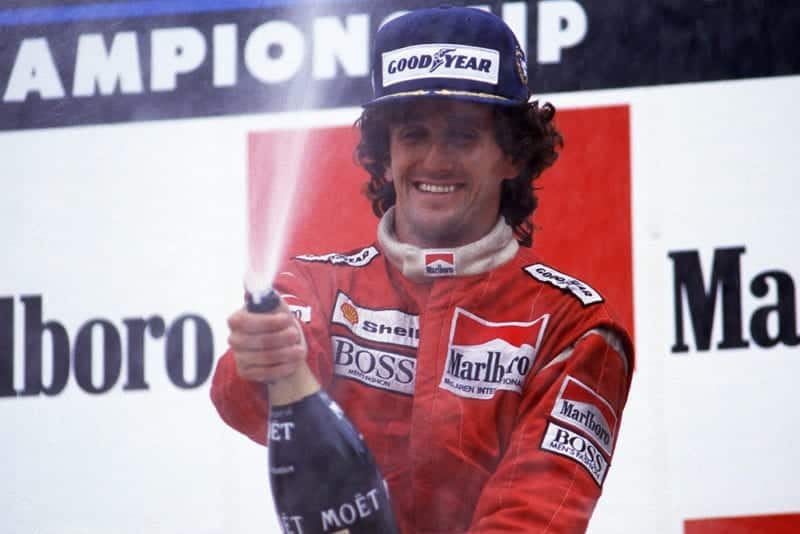
Race winner Alain Prost celebrates after equalling Jackie Stewarts record number of twenty-seven wins.
© Motorsport Images
Television viewers will have seen Mansell running round the outside of Senna, and the two cars pirouetting off the track. Newspaper readers will have read about Mansell’s anger against Senna in the pits afterwards. Regarding the collision you can take whichever side suits your fancy. Mansell fans will blame Senna, and Senna fans will blame Mansell, but the Brummie does make a (bad) habit of tangling with the hard Brazil nut. As regards the flare-up afterwards, I wonder what you would have done after goofing and throwing a race away by a stupid manoeuvre?
To end on a happy note, Honda must have been pleased with Satoru Nakajima finishing fifth in only his third Formula One race. Three starts as Lotus number two, and three finishes. That would have been good for a talented English driver.
After their disaster at Imola with the hurriedly-built Ligier-BMW cars, it was nice to see both cars finish, and Ghinzani would have finished close to Amoux had his car not run out of fuel on the last lap. DSJ
